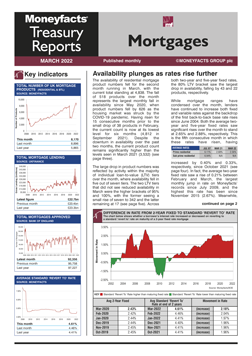Eleanor Williams, Finance Expert at Moneyfacts, said:
“Those hoping to secure a new mortgage may wish to act sooner rather than later to lock in a competitive option, as not only have average rates continued on an upwards trajectory this month, but prospective borrowers may find that their selected products are not on offer for long. April saw mortgage shelf-life plunge to 21 days, equal to the record low last recorded in August 2021, and reflecting a busy period of re-pricing as lenders have reacted to three back-to-back base rate rises and continued wider economic volatility.
“Overall average two- and five-year fixed rate mortgages have risen for the sixth consecutive month, both seeing notable monthly increases of 0.21% and 0.13% respectively. This reflects the fact that rates have risen across the majority of the lending tiers again and sees the average two-year fixed rate for all LTVs reach 2.86% - the highest on Moneyfacts records in over six years (June 2015 - 2.87%), while the five-year equivalent has breached 3% for the first time since October 2016 (3.02%).
“While fixed rates are not intrinsically linked to base rate and therefore are not set to rise exactly in line with its fluctuations, it is interesting to note that since December 2021 both the two- and five-year overall average fixed rates have risen by 0.57% and 0.42% respectively. This compares to the average two-year base-rate tracker rate, which has risen by 0.63% since December, which is roughly in line with the 0.65% rise in base rate since then.
“Those on their lender’s SVR may well have already felt the impact of the recent base rate rises from the Bank of England. Moneyfacts data shows that the average SVR has risen more slowly than might have been expected, increasing from 4.40% to 4.71% since December 2021. This is the highest this rate has been in two years (April 2020 – 4.71%) and means that borrowers sitting on the average SVR could potentially reduce their outgoings by over £200* per month by securing a mortgage in line with the current average two-year fixed rate.
“The appeal to switch to a mid-term fixed rate such as a five-year deal over historically cheaper short-term fixed rates based on price has lessened as rates have risen. The margin between two- and five-year average fixed rates has shrunk to just 0.15%, the lowest we have recorded since February 2013 (0.08%). However, as there is no guarantee rates will not continue to climb, the incentive to secure a competitive new fixed rate to provide shelter from potential further rate volatility remains, and as our top tables show, there are still products with extremely competitive rates available, but the support and advice of a broker in securing these could be wise.”
* Calculations based on £200,000 outstanding mortgage balance over a 25-year term, with rates of 4.71% or 2.86%.
Eleanor Williams, Finance Expert at Moneyfacts, said:
“Those hoping to secure a new mortgage may wish to act sooner rather than later to lock in a competitive option, as not only have average rates continued on an upwards trajectory this month, but prospective borrowers may find that their selected products are not on offer for long. April saw mortgage shelf-life plunge to 21 days, equal to the record low last recorded in August 2021, and reflecting a busy period of re-pricing as lenders have reacted to three back-to-back base rate rises and continued wider economic volatility.
“Overall average two- and five-year fixed rate mortgages have risen for the sixth consecutive month, both seeing notable monthly increases of 0.21% and 0.13% respectively. This reflects the fact that rates have risen across the majority of the lending tiers again and sees the average two-year fixed rate for all LTVs reach 2.86% - the highest on Moneyfacts records in over six years (June 2015 - 2.87%), while the five-year equivalent has breached 3% for the first time since October 2016 (3.02%).
“While fixed rates are not intrinsically linked to base rate and therefore are not set to rise exactly in line with its fluctuations, it is interesting to note that since December 2021 both the two- and five-year overall average fixed rates have risen by 0.57% and 0.42% respectively. This compares to the average two-year base-rate tracker rate, which has risen by 0.63% since December, which is roughly in line with the 0.65% rise in base rate since then.
“Those on their lender’s SVR may well have already felt the impact of the recent base rate rises from the Bank of England. Moneyfacts data shows that the average SVR has risen more slowly than might have been expected, increasing from 4.40% to 4.71% since December 2021. This is the highest this rate has been in two years (April 2020 – 4.71%) and means that borrowers sitting on the average SVR could potentially reduce their outgoings by over £200* per month by securing a mortgage in line with the current average two-year fixed rate.
“The appeal to switch to a mid-term fixed rate such as a five-year deal over historically cheaper short-term fixed rates based on price has lessened as rates have risen. The margin between two- and five-year average fixed rates has shrunk to just 0.15%, the lowest we have recorded since February 2013 (0.08%). However, as there is no guarantee rates will not continue to climb, the incentive to secure a competitive new fixed rate to provide shelter from potential further rate volatility remains, and as our top tables show, there are still products with extremely competitive rates available, but the support and advice of a broker in securing these could be wise.”
* Calculations based on £200,000 outstanding mortgage balance over a 25-year term, with rates of 4.71% or 2.86%.










